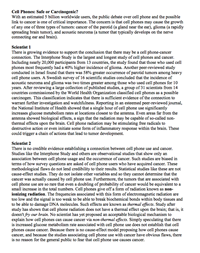 Cell Phone Radiation
Cell Phone Radiation
Resource:
The Science Reasoning Center: Cell Phone Radiation
Grade Level: High School
Description:
This passage describes the conflict between two scientists regarding the dangers associated with cell phone radiation. The rationale behind each scientist's conclusions is described. Questions target a student's ability to comprehend the thrust of each argument, to compare and contrast the reasoning involved, to identify the assumptions that underlie the claims, and to predict the impact that future findings might have upon the ongoing debate.
Performance Expectation:
HS-PS4-4 Evaluate the validity and reliability of claims in published materials of the effects that different frequencies of electromagnetic radiation have when absorbed by matter.
This activity aligns with the three dimensions of the Next Generation Science Standards in the manner described below:
Disciplinary Core Idea:
Electromagnetic Radiation (HS-PS4.B.2): Shorter wavelength electromagnetic radiation (ultraviolet, X-rays, gamma rays) can ionize atoms and cause damage to living cells. |
It is a well understood that shorter wavelength electromagnetic waves can ionize atoms causing damage to human tissue. What is understood to a lesser extent is the degree to which longer wavelength radiation can cause harm to living cells. This passage explores two scientists’ opposing viewpoints on the topic of cell phone (long wavelength) radiation and its potential connection to cancer. As each scientist argues their case, students will come to understand some of science behind this debate. |
| Scale, Proportion, and Quantity: The significance of a phenomenon is dependent on the scale, proportion, and quantity at which it occurs. |
Electromagnetic radiation is comprised of an entire spectrum of wavelengths and energies. Short wavelength radiation can ionize atoms and cause damage to living cells; long wavelengths are considered non-ionizing radiation and have much less (if any) of an effect on humans. And while the significance of the non-ionizing radiation from cell phones is at the heart of the controversy, the reader will clearly understand that the degree to which electromagnetic radiation can damage living cells varies significantly over the entire spectrum. |
| Cause and Effect: Cause and effect relationships can be suggested and predicted for complex natural and human designed systems by examining what is known about smaller scale mechanisms within the system. |
Understanding the physical effects of cell phone radiation on human tissue is central to this passage. And while the two scientists disagree regarding the extent to which such radiation can damage living cells, they both point to the radiation’s impact (or lack thereof) at the atomic level. As such, this passage clearly addresses the cross-cutting concept of cause and effect as it illustrates that such relationships can be suggested for complex systems by examining what is known about small scale mechanisms with the body itself. |
| Obtaining, Evaluating, and Communicating Information: Critically read scientific literature adapted for classroom use to determine central ideas and obtain scientific/technical information. |
The text in this passage is comprised of scientific research outlining two opposing views of the dangers of radiation from cell phone usage. Students need to understand the central thrust of each scientist’s argument; however, they must also read carefully to obtain and evaluate particular information as evidence in addressing the end-of-passage questions. Both the skill of see the ‘big picture’ as well as finding specific details within scientific text are important for students as they develop the ability to obtain, evaluate, and communicate technical information. |
| Engaging in Argument from Evidence: Evaluate the evidence behind currently accepted explanations to determine the merits of arguments. |
Students consider two scientists’ opposing perspectives regarding the physical dangers of extensive cell phone use. Questions at the close of this passage target a student's ability to comprehend the main thrust of each argument, to compare and contrast the reasoning involved, to identify the assumptions that underlie the claims, and to predict the impact that future findings might have upon the ongoing debate. |
Associated Reading from The Physics Classroom
Other Supporting Pages at The Physics Classroom:
View Infographic.
(Coming Soon)
Search the NGSS Corner
Maybe you're looking for something really specific that pertains to a desired topic and emphasizes one or more of the listed NGSS dimensions. Why not try a search of this section of our website? Simply select from one or more of the pull-down menus and click Search This page will reload and a collection of possibilities will be displayed in this section of the page and sorted by relevancy.